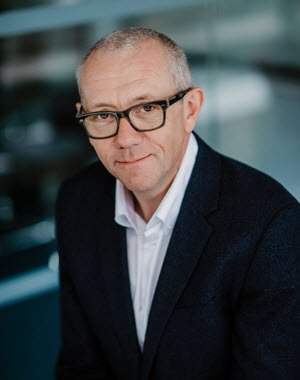Q&A: Ciena's Jamie Jefferies talks EMEA telecom trends
Jamie Jefferies has been with Ciena for more than 18 years, operating in the US and European arenas for both Nortel and Ciena. He returned to London a few months ago as the new VP and General Manager of Europe, Middle East and Africa (EMEA). This comes after a successful leadership position as VP of Sales in North America for Strategic Accounts.
In that role, Jamie oversaw key initiatives with many of Ciena’s largest customers, including Verizon, where he was instrumental in advancing Ciena’s position as a strategic partner. In fact, Glenn Wellbrock, Verizon’s Director of Optical Transport Network Architecture, Design & Planning, shared with us the following observations about Jamie:
“I’ve worked with Jamie for nearly a decade, and he has been an outstanding contributor to the success of both Verizon and Ciena. He is honest and open, both internally and externally, thus building a reputation of someone you can trust to do what is best for both companies. I consider Jamie a friend and think Ciena made an excellent choice in selecting him to lead its European operations.”- Glenn Wellbrock, Verizon’s Director of Optical Transport Network Architecture, Design & Planning
Jamie re-joins the EMEA team at a time when the region achieved 15% year-over-year growth from 2017-18, a rate that is faster than the market and faster than the overall Ciena business.
In addition, Ciena has recently experienced expansion in customer footprint in the region, particularly with new Tier 1 service providers, including a strategic win with Deutsche Telekom Global Services. EMEA has also benefited from ICP growth, a sector where Ciena has strength globally and continues to pursue additional market share.
We carved out some time in our day to talk to Jamie Jefferies and ask for his thoughts about our industry, his goals for Ciena EMEA and what keeps the batteries charged for a busy guy like him. Below is our conversation:
Christine Keck: Welcome back to your EMEA roots! What are the key trends you expect to shape the EMEA market and your team in the next 2-3 years?
 Jamie Jefferies: There is an unrelenting demand for content, and the way we
access and consume this content with new applications and devices is driving the need for network transformation.
This is germane to our business, because it includes moving large quantities of data for, by way of example,
manufacturing systems and tools, healthcare and education or even flexible working. These trends all drive the need
for huge capacity and performance in our customers’ networks, and they are making the price/cost/value
equation more important than ever to our customer base. These trends are also driving a change in our customer base
– the “hyperscalers/webscalers” have accumulated massive influence in our industry. There is price
pressure from them, and they drive their businesses with a different mindset.
Jamie Jefferies: There is an unrelenting demand for content, and the way we
access and consume this content with new applications and devices is driving the need for network transformation.
This is germane to our business, because it includes moving large quantities of data for, by way of example,
manufacturing systems and tools, healthcare and education or even flexible working. These trends all drive the need
for huge capacity and performance in our customers’ networks, and they are making the price/cost/value
equation more important than ever to our customer base. These trends are also driving a change in our customer base
– the “hyperscalers/webscalers” have accumulated massive influence in our industry. There is price
pressure from them, and they drive their businesses with a different mindset.
The 5G story and the evolution of the wireless access networks to this next generation of technology is also a critical trend. EMEA may be a short step behind North America and APAC in implementing this technology, mostly due to economics and licensing – but it is coming. 5G will drive the need for greater “fiber densification” and higher capacities, and it will intensify the need for even higher network performance. This technology will be the true enabler of the “The Internet of Things (IoT),” with more and more devices, applications and demands hitting the network. This will have big implications on these networks, to our customers’ businesses and – importantly – to us.
Lastly, all these things will amplify the need to drive automation to ensure operating costs are managed, that speed and velocity are not compromised and that the customer experience is one of superior quality.
If we can help customers operationally simplify their networks, it will have an enormous positive impact on the cost of operating their businesses. And if we can also help them to deliver services faster and get to market more rapidly, it will have an enormous positive impact on growing their businesses.
CK: Addressing that topic of automation and simplification, where do you see opportunities for Blue Planet and software?
JJ: We have a tremendous opportunity to help our customers tackle and exploit the trends I mentioned above. Ciena’s Adaptive Network brings together our programmable network infrastructure; a rich Blue Planet software suite to orchestrate, control and operate networks; and an insight-led services business to help implement and support our customers’ evolution. The acquisitions we have made over the last 12-24 months have been very smart and help us uniquely address the challenges our customers face globally.
If we can help customers operationally simplify their networks, it will have an enormous positive impact on the cost of operating their businesses. And if we can also help them to deliver services faster and get to market more rapidly, it will have an enormous positive impact on growing their businesses.
Ciena’s vision of the Adaptive Network is very clear – and our solutions, underpinned by a culture of innovation, trust and fantastic customer relationships, set us apart in the industry. As a company, we continue to innovate on all aspects of the Adaptive Network, and we’ll support that in EMEA with continued collaboration and focus in these key areas.
CK: Europe implemented the General Data Protection Regulation (GDPR) in May 2018. How do you see implementation of that regulation continuing to play out?
JJ: Our customer and partner, Vodafone, recently issued its "Global Trends Barometer 2019," and the #1 key business trend they identified for 2019 is trust: “… trustworthiness has become a valuable commodity. In this context, trustworthiness is defined by keeping data safe and being transparent with the use of data.”
This topic will only grow in importance. Ciena’s focus on encryption and the ability to keep in-flight data secure will continue to increase – it’s one of the many ways enterprises and network operators can together support data integrity.
CK: The Middle East is a key part of EMEA, with IP traffic capacity in the Middle East region forecast to increase by a CAGR of 41% between 2018-2022. That’s a lot of growth. Where does Ciena see opportunities in the Middle East?
JJ: Ciena has invested heavily in this region. We have offices and great people there, and we are firmly committed to it as a part of our growth strategy.
The Middle East region itself has committed to shift its investment strategy away from the traditional revenue stream of oil and on to other things, including tech. Ciena has developed a number of strong relationships in the region, and together we are innovating and deploying networking solutions that intercept the market opportunities that exist in the region. We are tremendously excited about the results we are seeing and the opportunities ahead of us.
Our partner network is mission-critical for us. It’s a force-multiplier for our relationships, driving value for our partners, their customers and ourselves.
CK: Ciena recently launched a refreshed global partner program, the Ciena Partner Network (CPN). How will that program and strategy play out in EMEA?
JJ: Our partner network is mission-critical for us. It’s a force-multiplier for our relationships, driving value for our partners, their customers and ourselves. The new CPN program is designed to offer a more customized relationship with each partner, based on an annual business plan that we develop jointly with the partner. It’s our goal to drive more sales for the partner and for Ciena, built from a platform that allows each partner to be flexible and respond to changing conditions in their marketplace. We are also delivering more training through the CPN, allowing the partner to sell with more intelligence and confidence about the Ciena solutions.
We have a very strong partner network throughout EMEA, and it is our intent to build it to be even stronger.
CK: Jamie, what do you do away from work for fun?
JJ: I have two boys, one in university and one soon on his way. I spend as much time with them as I can. We are all very passionate football fans [editor’s note: “soccer” in US parlance]. Now that I’m back in London, I hope to spend more time at live matches.
I am also a very avid triathlete, with an emphasis on running and biking. Running used to be my passion, but when I hit 40, I bought a bike and never looked back. Today, I ride about 8,000 miles/year, and I run about 1,000 miles/year. I’ve done a few Ironman events, with the Lake Placid Ironman being my favorite. I hope to continue training to do another one in the next 18-24 months – I use it as a great outlet from the day-to-day pressures of work and travel.




